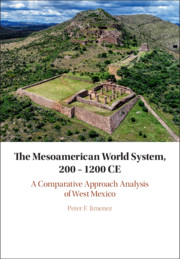Book contents
- The Mesoamerican World System, 200–1200 CE
- The Mesoamerican World System, 200–1200 CE
- Copyright page
- Dedication
- Contents
- Figures
- Tables
- Acknowledgments
- Abbreviations
- Chapter One West Mexico Coalesced
- Chapter Two The Comparative World-Systems Approach and Its Application to Archaeology
- Chapter Third The Regional Setting of West Mexico at 200 CE
- Chapter Four The Late Formative–Early Classic Period Transition 200/250–550 CE
- Chapter Five World-System Decentralization
- Chapter Six The Early Postclassic Period Transformation of West Mexico 900–1200 CE
- Chapter Seven West Mexico in the Mesoamerican World System
- References
- Index
Chapter Four - The Late Formative–Early Classic Period Transition 200/250–550 CE
Published online by Cambridge University Press: 10 August 2020
- The Mesoamerican World System, 200–1200 CE
- The Mesoamerican World System, 200–1200 CE
- Copyright page
- Dedication
- Contents
- Figures
- Tables
- Acknowledgments
- Abbreviations
- Chapter One West Mexico Coalesced
- Chapter Two The Comparative World-Systems Approach and Its Application to Archaeology
- Chapter Third The Regional Setting of West Mexico at 200 CE
- Chapter Four The Late Formative–Early Classic Period Transition 200/250–550 CE
- Chapter Five World-System Decentralization
- Chapter Six The Early Postclassic Period Transformation of West Mexico 900–1200 CE
- Chapter Seven West Mexico in the Mesoamerican World System
- References
- Index
Summary
The period 200–250 CE was a dynamic time in Central Mexico. Over the semi-arid plain of the northeastern Basin of Mexico the urban zone of Teotihuacan covered approximately 20 square km, containing a population of between 80,000 and 100,000 people (Cowgill 2015: 79; Millon 1981: 221). The monumental structures of the ceremonial precinct (i.e., La Ciudadela, the Pyramid of the Sun, and the Pyramid of the Moon) were already in place, subsequently undergoing periodic augmentations throughout the next two centuries (Sugiyama 2012: 221). Concurrently, the state of Teotihuacan (Figure 4.1) undertook expansion beyond the Basin of Mexico into adjacent areas of Central Mexico in order to secure a sustaining hinterland (Hirth 1978).
- Type
- Chapter
- Information
- The Mesoamerican World System, 200–1200 CEA Comparative Approach Analysis of West Mexico, pp. 42 - 92Publisher: Cambridge University PressPrint publication year: 2020

